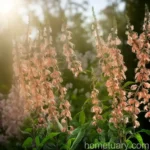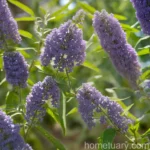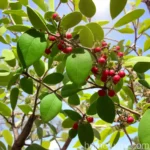Cape Fuchsia (Phygelius aequalis ‘Crocorpri’ CROFTWAY CORAL PRINCESS): A Comprehensive Guide
Introduction
Cape fuchsia, scientifically known as Phygelius aequalis ‘Crocorpri’ or CROFTWAY CORAL PRINCESS, is a stunning perennial plant that originates from South Africa. This beautiful and vibrant flowering plant belongs to the Scrophulariaceae family and is a popular choice among gardeners due to its colorful tubular flowers and its ability to attract pollinators such as bees, butterflies, and hummingbirds.
In this comprehensive guide, we will explore all aspects of Cape fuchsia, including its culture, uses, care requirements, diseases, and much more. By the end of this article, you will have a thorough understanding of how to cultivate and maintain this exquisite plant in your own garden.
What is Cape Fuchsia?
Cape fuchsia is a striking evergreen perennial that features elongated, rhizomatous clumps of dark green foliage. The most notable feature of this plant is its long, tubular flowers that bloom in clusters at the end of its stems. The flowers can range in color from vibrant reds and oranges to soft pinks and creamy yellows, adding a splash of color to any garden landscape.
Key Takeaways
Before delving deeper into the specifics of Cape fuchsia, let’s summarize some of the key takeaways about this beautiful plant.
- Scientific Name: Phygelius aequalis ‘Crocorpri’
- Common Name: Cape fuchsia
- Variety: CROFTWAY CORAL PRINCESS
- Family: Scrophulariaceae
- Origin: South Africa
- Attraction: Attracts pollinators such as bees, butterflies, and hummingbirds
- Foliage: Evergreen with dark green leaves
- Flowers: Tubular in various colors including red, orange, pink, and yellow
Now, let’s dive into the detailed aspects of Cape fuchsia, from its culture and uses to its care requirements and propagation techniques.
Culture
Understanding the cultural requirements of Cape fuchsia is essential for successfully cultivating and maintaining this plant. From the right soil conditions to suitable pruning techniques, let’s explore each aspect in detail.
Uses
Cape fuchsia is a versatile plant that can serve various purposes in a garden or landscape. Some common uses of Cape fuchsia include:
- Border Plant: Its vibrant flowers and evergreen foliage make it an excellent choice for bordering garden beds and pathways.
- Pollinator Attraction: Cape fuchsia’s nectar-rich flowers make it a magnet for bees, butterflies, and hummingbirds, making it a valuable addition to wildlife and pollinator gardens.
- Container Planting: It can be grown in containers or pots, adding color and visual interest to porches, patios, or balconies.
- Cut Flowers: The long-lasting flowers of Cape fuchsia can be cut and used in floral arrangements, bringing the beauty of the garden indoors.
- Ground Cover: When planted in mass, it can form an attractive ground cover, especially in areas with partial shade.
Water
Cape fuchsia requires regular watering, especially during the growing season and in dry spells. However, it’s important to strike a balance, as overwatering can lead to root rot, while underwatering can result in wilting and reduced flower production.
Watering Tips:
- Frequency: Water Cape fuchsia deeply but less frequently, allowing the soil to partially dry out between waterings.
- Morning Watering: Water in the morning to allow foliage to dry during the day, reducing the risk of fungal diseases.
- Mulching: Applying a layer of organic mulch around the base of the plant helps retain soil moisture and regulates the soil temperature.
Sunlight
Cape fuchsia thrives in bright, filtered sunlight and partial shade. While it can tolerate full sun, especially in cooler climates, it appreciates some relief from intense afternoon sun, particularly in warmer regions.
Sunlight Requirements:
- Morning Sun: Provide at least 4-6 hours of morning sunlight for healthy growth and abundant flowering.
- Afternoon Shade: Where possible, ensure some protection from the harsh afternoon sun to prevent wilting and sunburn.
Fertilizer
To promote healthy growth and prolific flowering, Cape fuchsia benefits from regular feeding with a balanced fertilizer during the growing season. A slow-release or liquid fertilizer formulated for flowering plants can provide the necessary nutrients for robust growth and vibrant blooms.
Fertilizing Guidelines:
- Frequency: Apply fertilizer every 4-6 weeks during the growing season, from spring to early fall.
- Dilution: Dilute liquid fertilizers to half-strength to prevent the risk of overfeeding and burning the roots.
- Winter Rest: Reduce or cease fertilization during the winter months when the plant is in its dormant phase.
Soil
Well-draining, fertile soil is crucial for the successful cultivation of Cape fuchsia. It prefers slightly acidic to neutral soil with good aeration and moisture retention capacity.
Soil Preferences:
- Composition: Use a well-draining soil mix rich in organic matter such as compost or peat moss to enhance soil fertility and structure.
- pH Level: Aim for a pH range of 6.0 to 6.5 for optimal nutrient uptake and overall plant health.
- Container Soil: When growing in containers, choose a high-quality potting mix specifically designed for flowering perennials.
Pruning
Pruning is an essential aspect of Cape fuchsia maintenance, helping to promote bushy growth, maintain an attractive shape, and prolong the flowering period. Regular deadheading and occasional shaping can enhance the plant’s overall appearance.
Pruning Tips:
- Deadheading: Remove spent flowers regularly to encourage continuous blooming and prevent the plant from setting seeds.
- Spring Pruning: Trim back any frost-damaged or leggy growth in early spring to stimulate new growth and improve the plant’s vigor.
- Shape Control: Trim the plant to maintain a compact and tidy form, especially after the flowering season.
Propagation
Cape fuchsia can be propagated through various methods, including division, stem cuttings, and seed sowing. Each propagation technique has its advantages and requirements, allowing gardeners to expand their Cape fuchsia collection or share the plant with others.
Propagation Methods:
Division:
- Timing: Divide mature clumps in early spring before new growth emerges for best results.
- Steps: Dig up the clump, gently separate the individual rhizomes, and replant the divisions in prepared soil.
Stem Cuttings:
- Preparation: Take 4-6 inch stem cuttings from healthy, non-flowering shoots in late spring or early summer.
- Rooting: Dip the cut ends in rooting hormone and plant them in a well-draining propagation mix, keeping them consistently moist until roots develop.
Seed Sowing:
- Collection: Harvest ripe seeds from spent flower heads and store them in a cool, dry place until ready for sowing.
- Sowing: Plant the seeds in seed-starting trays or pots filled with a well-draining seed starting mix, covering them lightly with soil.
Container Popularity
Cape fuchsia’s adaptability and ornamental value make it a popular choice for container gardening. Its ability to thrive in containers allows gardeners with limited space, such as balconies or small patios, to enjoy its vibrant flowers and wildlife-attracting properties.
Common Diseases
While Cape fuchsia is relatively resistant to diseases, it can occasionally face issues such as fungal infections and root rot under unfavorable growing conditions. Familiarizing yourself with the common diseases and their prevention measures is crucial for maintaining the plant’s health.
Disease Diagnosis
- Powdery Mildew: A common fungal disease that appears as a white powdery coating on the foliage, typically caused by poor air circulation and high humidity.
- Root Rot: Excessive soil moisture and poor drainage can lead to root rot, characterized by wilting, yellowing foliage, and a foul odor from the roots.
Common Pests
Cape fuchsia is generally resistant to most pests, but it can occasionally attract aphids, spider mites, and whiteflies. Regular monitoring, cultural practices, and natural predators can help manage and prevent pest infestations.
Botanist’s Tips
To ensure the successful growth and vitality of Cape fuchsia, consider the following botanist’s tips:
- Mulching: Apply a layer of organic mulch around the plant to conserve soil moisture and suppress weed growth.
- Support: Provide support, such as stakes or trellises, for taller varieties to prevent the stems from bending or breaking under the weight of the flowers.
- Winter Protection: In colder regions, insulate the base of the plant with a layer of mulch or straw during the winter to protect the roots from freezing temperatures.
Fun Facts
- Cape fuchsia is named for its resemblance to the fuchsia plant, despite not being botanically related to it.
- The tubular flowers of Cape fuchsia are designed to attract long-tongued pollinators such as bees and hummingbirds.
- It is a valuable addition to butterfly and wildlife gardens, providing a source of nectar and habitat for beneficial insects.
Conclusion
In conclusion, Cape fuchsia (Phygelius aequalis ‘Crocorpri’) is a delightful and versatile perennial plant that offers a myriad of benefits to gardeners and wildlife alike. From its vibrant flowers and foliage to its resilience and ease of cultivation, this South African native has rightfully earned its place in gardens and landscapes around the world.
By understanding its cultural needs, propagation methods, and maintenance practices, you can enjoy the beauty of Cape fuchsia while contributing to the preservation of pollinators and the overall biodiversity of your garden.
Whether used as a striking border plant, a colorful addition to a container garden, or a focal point in a pollinator-friendly landscape, Cape fuchsia holds its own as a charming and beneficial plant that deserves a place in any garden enthusiast’s collection.
Links to External Resources
For further information, resources, and where to find Cape fuchsia plants, you can explore the following external links:
- Royal Horticultural Society – Growing Phygelius
- The Spruce – Cape Fuchsia Profile
- Missouri Botanical Garden – Phygelius aequalis
- Gardeners’ World – Cape Fuchsia Tips
I hope this comprehensive guide provides you with the knowledge and inspiration to cultivate and enjoy the beauty of Cape fuchsia in your own garden or landscape.
Happy gardening!
Note: The information provided in this article is for educational and informational purposes and should not be considered as professional horticultural or botanical advice. Always consult with a local gardening expert or nursery for specific guidance tailored to your unique growing conditions and requirements.
















